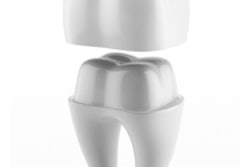
Is the primary focus of a modern-day periodontal practice the preservation of natural teeth or has it shifted to the placement of aesthetically pleasing and functional implants?
A new study that surveyed periodontists, hygienists, and general practitioners about the scope of periodontics found that most agreed surgical treatment of advanced gum and bone infection is the most important therapeutic focus of being a periodontist, but there was disagreement over the importance of implant placement and related procedures (Journal of Periodontology, February 28, 2014).
Study co-author Paul A. Levi Jr., DMD, an associate clinical professor at the Tufts University School of Dental Medicine, told DrBicuspid.com that he was an examiner for the American Board of Periodontology in 2007 when, during a talk with the executive director regarding the examination of the candidates for board certification, they realized that half of the exam related to placing implants.
“Our forefathers, prior to implantology, would do all possible to retain a natural tooth.”
"We asked each other if periodontology was changing from a discipline which tried to retain and treat a natural tooth to one where we would extract a natural tooth and replace it with an implant," Dr. Levi said. "Our forefathers, prior to implantology, would do all possible to retain a natural tooth. Granted, implants have a big role in restorative dentistry, as there are teeth that cannot be successfully treated; however, are we giving up on natural teeth too soon without attempting to treat them?"
They asked each other "How do we as periodontists define ourselves in our scope of practice?" and that was the incentive to begin their research.
In this pilot study, Dr. Levi and his colleagues developed a survey in two stages. They sent out an initial questionnaire, asking "What is a periodontist?" to general dentists, specialists, hygienists, assistants, dental and hygiene students, and patients. Out of 600 requests, 275 responses were received from 2007 to 2009.
The results from this survey were then consolidated into eight statements, and another group of respondents were then asked to rank the statements from most to least important regarding their definition of a periodontist. Between January 2012 and May 2012, the study authors received 1,212 responses and used 919 of them. Survey respondents included 355 periodontists, 249 nonperiodontist dentists, and 315 hygienists.
The researchers found that periodontists considered the statement "periodontists surgically treat advanced gum and bone infection problems" to expresses their most important function. In fact, this was considered the most important function across all groups, including various periodontal cohorts, as well as among hygienists and nonperiodontist dentists.
The study authors noted that periodontists did rank that function as most important less frequently than other groups. "This indicates that periodontists have a broader perception of their scope of practice than the nonperiodontal cohorts," they wrote.
For periodontist responders, if implantology was part of their educational curriculum (1992 or before, and 1993 or later), it had a significant impact on their answers.
"With the advent of implants, periodontists tend to do prescriptive treatments, such as placing implants or grafting areas for implant placement, in addition to being advisors to dentists for the evaluation of natural teeth for restoration/prosthetic purposes," the study authors noted.
The researchers also found statistically significant differences between periodontists and hygienists when it came to three statements, including "periodontists promote research to better understand periodontal diseases, their effect on systemic health, and their related therapies," and "periodontists treat aesthetically compromised periodontal conditions through bone and soft-tissue procedures," which were more important to hygienists in defining periodontists than they were to the specialsts themselves.
The authors noted that both general dentists and hygienists ranked the statement regarding research higher than periodontists, indicating that these two groups consider periodontists the expert in treating the natural dentition.
They also found a statistically significant difference in four statements when comparing the responses of periodontists and nonperiodontists. "Periodontists surgically treat advanced gum and bone infection problems" and "periodontists treat aesthetically compromised periodontal conditions through bone and soft-tissue procedures" statements were more important to nonperiodontists than periodontists.
On the other hand, the statements of "periodontists perform dental implants and related procedures" and "periodontists are advisors to other dental and medical professionals in regards to diagnosis, prognosis, and treatment planning" were more important to periodontists.
In fact, periodontists ranked placing implants as second most important, while nonperiodontists ranked it fifth. This indicates that general dentists and other specialists likely feel that placing implants is not exclusive to periodontists.
Meanwhile, nonperiodontist dentists and hygienists felt that the second most important aspect of periodontics is that "periodontist treatments help general dentists and other specialists increase successful therapeutic outcomes with their patients."
"This shows that nonperiodontist participants of this survey very much appreciate that periodontists enhance the results of their therapy," the authors wrote.
Also, general dentists and hygienists considered the statement "periodontists treat aesthetically compromised periodontal conditions through bone and soft-tissue procedures" as more important than did periodontists.
The authors noted that general dentists and hygienists perceive the specialty differently than periodontists, and communication by the periodontist to the general dentist is important to provide knowledge of their scope of practice and guidance for their therapies.
Dr. Levi told DrBicuspid.com that it is interesting to note that periodontists consider the second most important aspect of their practice as implants or implant-related procedures, while restorative dentists and hygienists feel that the assistance that periodontists give to their patients in achieving good results with treatment is much more important than periodontists doing implants.
"We feel the reason for this is that many other dentists place implants besides periodontists, yet periodontists help other dental practitioners achieve successful results with therapy," he said.
Although implant placement is an integral part of a periodontist's training and skill, periodontists can use this information to realize that a significant benefit of their therapy is helping their patients, who are the patients of their referring dentists, to achieve biological health, Dr. Levi noted.
"This health is through the reduction/elimination of inflammation as well as improvement of aesthetics through soft-tissue grafting procedures," he concluded.



















